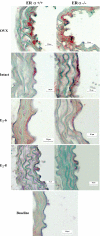17beta-estradiol prevents early-stage atherosclerosis in estrogen receptor-alpha deficient female mice
- PMID: 19654889
- PMCID: PMC2719738
- DOI: 10.1007/s12265-009-9103-z
17beta-estradiol prevents early-stage atherosclerosis in estrogen receptor-alpha deficient female mice
Abstract
Estrogen is atheroprotective and a high-affinity ligand for both known estrogen receptors, ERalpha and ERbeta. However, the role of the ERalpha in early-stage atherosclerosis has not been directly investigated and is incompletely understood. ERalpha-deficient (ERalpha-/-) and wild-type (ERalpha+/+) female mice consuming an atherogenic diet were studied concurrent with estrogen replacement to distinguish the actions of 17beta-estradiol (E(2)) from those of ERalpha on the development of early atherosclerotic lesions. Mice were ovariectomized and implanted with subcutaneous slow-release pellets designed to deliver 6 or 8 mug/day of exogenous 17beta-estradiol (E(2)) for a period of up to 4 months. Ovariectomized mice (OVX) with placebo pellets (E(2)-deficient controls) were compared to mice with endogenous E(2) (intact ovaries) and exogenous E(2). Aortas were analyzed for lesion area, number, and distribution. Lipid and hormone levels were also determined. Compared to OVX, early lesion development was significantly (p < 0.001) attenuated by E(2) with 55-64% reduction in lesion area by endogenous E(2) and >90% reduction by exogenous E(2). Compared to OVX, a decline in lesion number (2- to 4-fold) and lesser predilection (~4-fold) of lesion formation in the proximal aorta also occurred with E(2). Lesion size, development, number, and distribution inversely correlated with circulating plasma E(2) levels. However, atheroprotection was independent of ERalpha status, and E(2) athero-protection in both genotypes was not explained by changes in plasma lipid levels (total cholesterol, triglyceride, and high-density lipoprotein cholesterol). The ERalpha is not essential for endogenous/exogenous E(2)-mediated protection against early-stage atherosclerosis. These observations have potentially significant implications for understanding the molecular and cellular mechanisms and timing of estrogen action in different estrogen receptor (ER) deletion murine models of atherosclerosis, as well as implications to human studies of ER polymorphisms and lipid metabolism. Our findings may contribute to future improved clinical decision-making concerning the use of hormone therapy.
Figures






Similar articles
-
Susceptibility to early atherosclerosis in male mice is mediated by estrogen receptor alpha.Arterioscler Thromb Vasc Biol. 2004 Jun;24(6):1055-61. doi: 10.1161/01.ATV.0000130467.65290.d4. Epub 2004 Apr 29. Arterioscler Thromb Vasc Biol. 2004. PMID: 15117737
-
Protection against atherosclerosis by estrogen is independent of plasma cholesterol levels in LDL receptor-deficient mice.J Lipid Res. 1999 May;40(5):893-900. J Lipid Res. 1999. PMID: 10224158
-
Estrogen-dependent activation of neutral cholesterol ester hydrolase underlying gender difference of atherogenesis in apoE-/- mice.Atherosclerosis. 2011 Dec;219(2):545-51. doi: 10.1016/j.atherosclerosis.2011.08.051. Epub 2011 Sep 12. Atherosclerosis. 2011. PMID: 21944698
-
Estrogen receptor-alpha gene expression in the cortex: sex differences during development and in adulthood.Horm Behav. 2011 Mar;59(3):353-7. doi: 10.1016/j.yhbeh.2010.08.004. Epub 2010 Aug 14. Horm Behav. 2011. PMID: 20713055 Free PMC article. Review.
-
A historical view of estrogen effect on arterial endothelial healing: From animal models to medical implication.Atherosclerosis. 2021 Dec;338:30-38. doi: 10.1016/j.atherosclerosis.2021.10.013. Epub 2021 Nov 3. Atherosclerosis. 2021. PMID: 34785429 Review.
Cited by
-
Testosterone-derived estradiol production by male endothelium is robust and dependent on p450 aromatase via estrogen receptor alpha.Springerplus. 2013 May 9;2(1):214. doi: 10.1186/2193-1801-2-214. Print 2013 Dec. Springerplus. 2013. PMID: 23741647 Free PMC article.
-
CYP17A1 deficient XY mice display susceptibility to atherosclerosis, altered lipidomic profile and atypical sex development.Sci Rep. 2020 May 29;10(1):8792. doi: 10.1038/s41598-020-65601-0. Sci Rep. 2020. PMID: 32472014 Free PMC article.
-
Mutated CYP17A1 promotes atherosclerosis and early-onset coronary artery disease.Cell Commun Signal. 2023 Jun 27;21(1):155. doi: 10.1186/s12964-023-01061-z. Cell Commun Signal. 2023. PMID: 37370070 Free PMC article.
-
GPER-novel membrane oestrogen receptor.Clin Sci (Lond). 2016 Jun 1;130(12):1005-16. doi: 10.1042/CS20160114. Clin Sci (Lond). 2016. PMID: 27154744 Free PMC article. Review.
-
17β-Estradiol Inhibits PCSK9-Mediated LDLR Degradation Through GPER/PLC Activation in HepG2 Cells.Front Endocrinol (Lausanne). 2020 Jan 30;10:930. doi: 10.3389/fendo.2019.00930. eCollection 2019. Front Endocrinol (Lausanne). 2020. PMID: 32082252 Free PMC article.
References
-
- {'text': '', 'ref_index': 1, 'ids': [{'type': 'DOI', 'value': '10.1056/NEJM199906103402306', 'is_inner': False, 'url': 'https://doi.org/10.1056/nejm199906103402306'}, {'type': 'PubMed', 'value': '10362825', 'is_inner': True, 'url': 'https://pubmed.ncbi.nlm.nih.gov/10362825/'}]}
- Mendelsohn, M. E., & Karas, R. H. (1999). The protective effects of estrogen on the cardiovascular system. New England Journal of Medicine, 340, 1801–1811. - PubMed
-
- {'text': '', 'ref_index': 1, 'ids': [{'type': 'PubMed', 'value': '13009853', 'is_inner': True, 'url': 'https://pubmed.ncbi.nlm.nih.gov/13009853/'}]}
- Stamler, J., Pick, R., & Katz, L. N. (1953). Prevention of coronary atherosclerosis by estrogen-androgen administration in the cholesterol-fed chick. Circulation Research, 1, 94–98. - PubMed
-
- {'text': '', 'ref_index': 1, 'ids': [{'type': 'PubMed', 'value': '2244855', 'is_inner': True, 'url': 'https://pubmed.ncbi.nlm.nih.gov/2244855/'}]}
- Adams, M. R., Kaplan, J. R., Manuck, S. B., Koritnik, D. R., Parks, J. S., Wolfe, M. S., et al. (1990). Inhibition of coronary artery atherosclerosis by 17-beta estradiol in ovariectomized monkeys. Lack of an effect of added progesterone. Arteriosclerosis, 10, 1051–1057. - PubMed
-
- {'text': '', 'ref_index': 1, 'ids': [{'type': 'PubMed', 'value': '8565178', 'is_inner': True, 'url': 'https://pubmed.ncbi.nlm.nih.gov/8565178/'}]}
- Chen, S. J., Li, H., Durand, J., Oparil, S., & Chen, Y. F. (1996). Estrogen reduces myointimal proliferation after balloon injury of rat carotid artery. Circulation, 93, 577–584. - PubMed
-
- {'text': '', 'ref_index': 1, 'ids': [{'type': 'PubMed', 'value': '9054863', 'is_inner': True, 'url': 'https://pubmed.ncbi.nlm.nih.gov/9054863/'}]}
- Oparil, S., Levine, R. L., Chen, S. J., Durand, J., & Chen, Y. F. (1997). Sexually dimorphic response of the balloon-injured rat carotid artery to hormone treatment. Circulation, 95, 1301–1307. - PubMed
